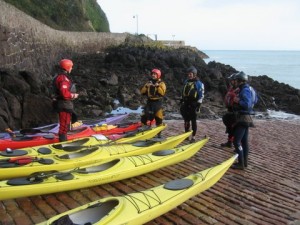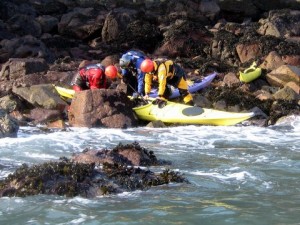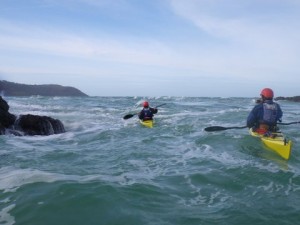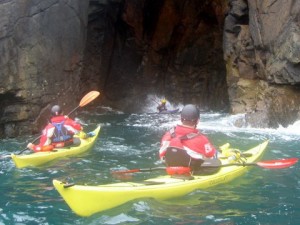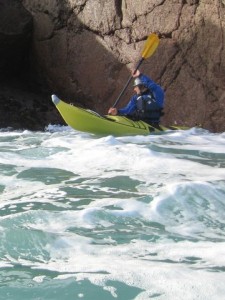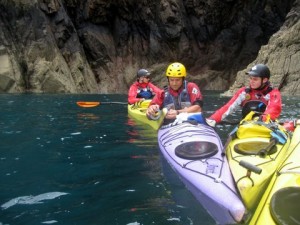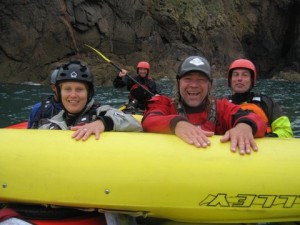How to prepare for the British Canoeing Sea Kayak Leader (4-Star) Award & Course Dates
2021 British canoeing (4-Star) Sea Kayak Leader training and assessment courses are listed here.
Note. The Sea Kayak Leader (SKL) assessment changed in January 2021. The award now offers two separate assessment routes: a tidal and a non-tidal waters assessment option. For most sea kayakers, the SKL tidal waters assessment will be the best option because it will allow you to lead in a broader range of conditions and waters.
I’ve written about some of the key changes to the Sea Kayak Leader (tidal) award and a few top tips here. Much of what is written below is still relevant. I’d strongly advise you to consider the importance of adopting a reflective approach. Use the Sea Kayak leader Checklist and action plan to help you to decide when you are ready to be assessed.
The requirement to attend SKL training will cease so paddlers can go directly to an assessment. Currently, I would only recommend this route if you have a lot of sea kayak leadership experience.
In theory, it will be possible to be assessed in one day. However, we will continue to offer a two-day assessment because this allows candidates more time to be evaluated in a range of conditions. A one-day assessment will be available on request.
More information will be posted once I have more details.
Our top tips for the British Canoeing (BCU) 4-star sea kayak leader award will help you get the most from your training and assessment course.
Dates and information about our advanced kayak courses and multi-day kayak trips.
This article isn’t called how to PASS your sea kayak leader assessment – that’s down to you, and how you prepare, but by following these top tips and ideas written by Phil Hadley (with a few of my updates) it should help you in your consolidation between BC (4-star) sea kayak leader training and assessment.
Note: The British Canoe Union (BCU) is now called British Canoeing (BC). In April 2017 the 4-star sea kayak award was renamed the Sea Kayak Leader (moderate water) award to reflect the content of the course. Since January 2021 you can choose to be assessed in tidal or non-tidal waters. I think most paddlers should choose the tidal waters option because this will extend their operating remit considerably and will increase their confidence.
The British Canoeing (4-star) Sea Kayak Leader training course
Your training course will be a good start on your path to a successful assessment, but there is no way, in two days you are going to learn everything required. The training course can only really give you an idea of what is expected of a sea kayak leader and help you to formulate your action plan to get you ready to achieve that.
Very few people can turn up to a two-day training then rock up to an assessment without doing anything in between and expect to pass – not unless you have loads of prior experience.
Go into your training with an open and enquiring mind, ask lots of questions, engage in meaningful discussions with the provider and the other candidates – be that ‘information sponge’ thirsty for knowledge!
Make sure that your skills are honed and that you are at your very best before the training, if you are constantly trying to keep your boat on track you aren’t going to be taking on all the information about leadership and group management. It’s difficult to concentrate on the subtleties of leadership strategies when you’re in survival mode!
Hopefully, you should come away from your training with an idea of your strong points, and more importantly, what you need to work on. This is where the real work starts!
Sea Kayak Leader Training & Assessment Dates.
Make an action plan
The first thing is to reflect on what you have learned and to write down an action plan, formulate some goals and set yourself time limits on when you aim to achieve these goals. (At Jersey Kayak Adventures all students leave with a personal action plan).
Be specific – ‘I want to improve my paddling’ doesn’t have the same meaning as ‘I need to improve my draws on the move on my left-hand side!’
Keep in touch with your training provider, discuss your action plan and improvements with them; some may be willing for you to come along to observe others being coached.
Providers often need ‘mock’ students for assessments so offer to be one of these, it’s a great way to see different styles of leadership, see where the ‘benchmark’ is – who passes, who doesn’t, and it’s a great insight into how an assessment works. Don’t be afraid to drop other 4-star leader providers a polite email; most are more than willing to give advice and possibly assist in your development.
Syllabus, Training and Assessment Notes for BC Sea Kayak Leader
Go to your Home Nation website (British Canoeing, Canoe Wales, SCA, CANI, BCNA) and download all the sea kayak leader documents and read them thoroughly. These are the standards you will be assessed against.
There’s a logbook that you can download, or you can produce your own. Whatever format you select make sure the assessor can see your personal paddling trips and any sea kayak leading you have done.
If you paddle different disciplines, try to have a section for each one. If you are thinking about getting into coaching, it’s a good idea to have a separate section for that too.
Personal Skills
You need to get into your kayak and get out paddling – lots! Practice your basic skills on flat-water to make sure that when you get onto moderate water, your fundamental strokes are all intuitive, make sure you practice on both sides and put as much variety as you can into your drills.
If you are short of time, it may be worth considering adding extra training days to our sea kayak leader training course.
We can also arrange training and assessment for the BC 3-Star sea kayak and Coastal Navigation & Tidal Planning (CNTP) certificate. Both are requirements for the sea kayak leader. We can also offer BC guide training modules: Camp Craft and Expedition Skills, Customer Experience, Trip-Planning and Organisation.
Custom dates can be arranged. Please email us.
Get someone to observe you and give you feedback, if that proves difficult set up a video camera on a tripod and self-analyse your techniques.
Don’t be afraid to get some specialist coaching. Just because you are working on the sea kayak leader award don’t assume that you wouldn’t benefit from some flat-water coaching. Using Wing paddles and Surfskis are a great way to tune up your forward paddling techniques. You need a large repertoire of techniques so that you can choose the most appropriate one when the need arises in a dynamic environment.
Paddle other types of boats. Lots of good sea kayakers have found their paddle awareness has improved by paddling canoes. Slalom and/or surf kayaking is a great way to improve your boat positioning and ability to read the water. Surf and white water is also a great place to develop a ‘bomb-proof’ roll!
We have a range of different craft including surf kayaks, sea kayaks and high-performance sea kayaks including Epic surfski designs. Plus a selection of Euro and Inuit style paddles.
Find other people in the same position as you, if you haven’t got paddling buddies at that level, get on the online paddling forums and find some.
Get into the habit of observing and giving feedback to your paddling buddies and try to nurture an atmosphere of peer support, coaching and improvement.
Moderate Water!
This should be your playground! You need to be super confident moving your boat around and putting it where you want in these conditions. Again variety is the spice of life, so go and explore!
Find out what moderate water means for your discipline, and make sure you have an appreciation for what that means in practical terms, especially on the sea and on open water canoeing.
The wider the range of moderate water situations that you put yourself in, the less chance of you having a nasty surprise on your assessment.
Most people who struggle with (4-star) sea kayak leader assessment often have weak logbooks in moderate water conditions. Make sure yours shows lots of trips at this level and lots of experience at leading different types of groups in the moderate water environment. Again, this may be a good reason to book a few extra days kayaking with us.
Mentors!
There are quite a few aspirant level 5-coaches and trainee level three coaches who are looking for ‘long-term students’ – offering to be coached by these guys is a great way to get some quality coaching, and it is always worth asking around. Again Internet paddling forums, Facebook etc. can be handy.
Leader!
The sea kayak leader is a leadership award, so make sure you get plenty of practice at leading in these environments. We see quite a few candidates fail their assessment because they have only led novice paddlers or have wrongly assumed that because they do a lot of kayak coaching they have developed the leading skills that are required at the sea kayak leader level. Remember, this is a leadership award based on you leading paddlers who are around the Sea Kayak award (roughly the old 3-star) level. Keep the group involved and part of the trip. Let those who clearly have the experience play an active role.
Give a good briefing and involve the group. We find it helps if you have a system for your briefing such as Area, Boats and equipment, Communication, Doctor -health/medical matters-, Emergency matters/protocols. You can put this on a small card as ABCDE and use this to remind you. Keep this briefing short and concise as your students will want to get on the water!
Remember to maintain good levels of Communication, Line of sight, Avoidance and select a Position of most usefulness (CLAP). Involve the paddlers in tricky areas so they “buddy-up” or use “mirrors”, so no one is ever out of sight.
Consider the route all the time as you paddle along. Look well ahead for “future water” so you can shape your route in advance. Use protocols such as SAFER (Stop, Assess, Formulate a plan, Execute the plan, i.e., do it, Reflect and modify) when looking at more tricky spots.
It can take a long time to move a group through some sections, and you might, therefore, need to adjust your plan/route based on the group size and experience. If you find you are taking a long time to explore a cave or rock garden, some members of the group may lose interest. Active paddlers like to be doing something so keep people involved and feeling part of the group.
If you opt for extra training days, we can often arrange opportunities for you to lead more experienced paddlers.
Offer to help out on club trips and ask if you can take the lead as often as possible. This is even better if it’s done under the supervision of a more experienced leader who can give you some feedback on your performance and suggest alternative strategies.
Even if you’re paddling with your friends, it’s good practice to have a leader, and for everyone to know their roles in the group, you can switch these roles around throughout the day, but turn every feature into a learning environment by discussing various strategies.
Kit
Ensure you are familiar with your equipment. Try out your new tow line before you need to use it for real in the training or assessment course. Remember, it is all very well to read about techniques and safety skills. However, you need to try them out for yourself to see if they will work for you. If you borrow gear and kayaks, expect to be assessed as if they were your own.
The Internet may be a great source of information, but not all of the advice will be relevant to you, and some are just wrong!
Candidates are expected to have a VHF marine radio, so make sure you know how it works. Carry it on your person and agree on a working channel if others in the group have a VHF with them. This makes communication between the group very easy and allows you to give advice, e.g. when leading the group in through large surf or to communicate with a team member who has gone out of shouting range.
Incidents
If you are being assessed at this level incident will happen. We have seen the following incident occur during our courses: broken paddles, lost hatches, damaged kayaks, paddlers needing tows, problems with using a kayak they had only just bought, a cut hand, capsizes in rock gardens, overestimating the group’s ability. None of these was set up by the assessors, and the key message is to be prepared.
Events can escalate rapidly. Remember your key priorities are: Self, Group, Swimmer, Equipment. Get this right, and you are likely to deal with the incident well and impress your assessors. If you have completed a first aid or Foundation Safety & Rescue Training (FSRT) course, this is going to be familiar to you.
Sadly, we often see paddlers forget this basic protocol and rush in to deal with incidents. Too often, I see leaders charging in and sometimes putting themselves at risk and even becoming the second person in difficulties. Before you charge in to assist consider if they can swim clear, climb out of danger. Will the problem be reduced if they do a few things to help get out of the predicament themselves.
I avoid calling the paddler in difficulties a victim. This implies they are incapable of doing anything to rectify their predicament. Instead, I call them a swimmer -which is usually what they will be-.
Another handy protocol is: Stop, Assess what is happening, Formulate a plan, Execute it (do it), Reflect on how it went afterwards.
Delegate
When paddlers often lead groups who are less experienced, they can end up in an assessment thinking they are the ones who need to deal with any incidents. Remember, the sea kayak leader is not alone; others in the group may have sufficient experience and kit to help deal with an incident.
Your role as a leader is to overseas the situation and in effect, managing things. Get yourself involved in towing, and you risk being locked into the tow when further problems arise. For example, if others have tow lines get them involved in the tow to free you up to ensure others things do not start going wrong. This is a good reason to check what gear and experience your group has before going afloat.
Too often, minor incidents generate a chain of consequences, so be ready to spot them before they escalate. When you are busy putting a paddler back into their kayak, it is easy to overlook what is happening to the others in the group…
Get fit!
The assessment can be physically tiring, often entailing long drives to the course venue, paddling all day for two days, working evenings looking at plans for the next day, self-rescues and rescuing boats in moderate water.
Assessors often see candidates flagging and losing performance towards the end of the two days – make sure you are as paddling fit as you can be. Try and give yourself a day before the assessment when you are not travelling to the course. We all lead busy lives so give yourself a bit of time out rather than plunge from a busy week at work on a Friday into the assessment on Saturday.
Pre-requisites
The new Sea Kayak Leader award no longer requires you to attend a training course, and you can go directly to an assessment. There are still some new prerequisites.
One thing you really need to be up to speed with is your ability to navigate. Since January 2021, you do not need to have completed a navigation course such as the Coastal Navigation & Tidal Planning. However, most paddlers will benefit from attending a Coastal Navigation and Tidal Planning course. We can usually add this as an extra day or as an online option.
The Coastal Sea Kayak award is a good benchmark to have when going to the sea kayak leader training course. Again, we can assess this.
Attending the training course doesn’t mean you are going to have all the skills necessary for your assessment automatically. They are training courses, and the techniques taught will need consolidation, there is a huge amount of information to be digested, and skills to be perfected.
There is definitely a ‘use it or lose it’ phenomenon around these pre-requisite courses. Just because you used to be able to throw a throw line, perform a slick X rescue or plot a tidal passage doesn’t mean you will still be able to do it in two years when you go for an assessment. Keep working on these skills and practice them in real conditions.
You must have an up to date 16 hour First Aid. Try to do an outdoor one, like REC or the BCU Aquatic First Aid. We can sometimes arrange a 16-hour first aid course for you.
Course Registration
When you think you are ready to take the assessment, and you have all the pre-requisites you need to register with your Home Nation (BC, CANI or SCA).
You must be a BC member to undertake the sea kayak leader assessment and pay the Leadership Registration fee. British Canoeing will accept certificates from awarding bodies that are not on their list, e.g. first aid, navigation, VHF awards, Safeguarding training. This often happens when non-UK residents want to be assessed. I am aware that in some European countries, 16-hour First Aid courses are being phased out. My current advice is to submit an Accredited Prior Learning (APL) from with a copy of your certificate and the course syllabus (in English). BC HQ can then decide if it meets the standards required.
If you need to fill in an Accredited Prior Learning (APL) form send a copy of your certificate and course syllabus (in English) to BC HQ. Contact me, and I can usually give advice.
You must have registered in advance with British Canoeing before your assessment. No registration means no assessment!
Note: Non-UK candidates will need to complete the International Leadership registration, which is a bit more expensive.
Go Kayaking!
Go paddling as much as you can but don’t forget to have fun! If you make all your trips interesting and exciting, then you and the people you are leading will learn so much more!
Put variety into your paddling, different venues, different paddling buddies, different disciplines, different boats all add to the breadth of experience that shows you as a competent, confident leader.
See you on the water!
Dates of our 4-star sea kayak leader and advanced courses.
Written by Phil Hadley, BCU Coach and moderate water Canoe and Sea Kayak assessor with additions added by Derek Hairon (2018,2019, 2020).
BC Moderate water (4 stars) sea training courses
Remember, many sea kayakers attend the moderate water sea kayak leader training courses as a means of gaining more experience of paddling in different waters and conditions. Training courses are not just for paddlers who plan to go for an assessment.
You can find more information about our sea kayak leader training and assessment courses as well as Coastal Navigation and Tidal Planning here.
Derek Hairon
Updated 10 December 2020 with details of the changes to the SKL award and the tidal and non-tidal options. Plus other corrections. A more detailed explanation of the changes to the Sea Kayak Leader award is here.

